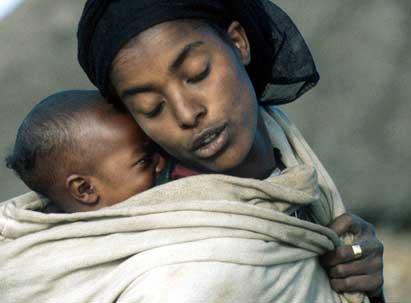Can the number of hungry people be halved?
2001/11/25 Carton Virto, Eider - Elhuyar Zientzia
The Panos Institute was created to spark a debate on the development of the world. This organization based in Britain has been in charge for fifteen years to publicize the situation of those who do not live as well as us. In his latest report, he analyzed the situation of people living with hunger, about 800 million people, and talked about the measures to be taken for the future and the evolution of agriculture.
According to the latest data, 792 million people suffer from chronic hunger in the world. This does not mean that nearly 800 million people risk starvation. To live well fed, each person needs between 1,710 and 1,960 kilocalories a day and everyone who lives with 400 kilocalories less falls into the category of those who go through chronic hunger.

Thus, there does not seem to be great differences between both situations, but it does exist, since eating intentionally and less than enough each day generates health problems. Chronic hunger hinders intellectual development, reduces productivity and weakens health. Two data: 20,000 people die every day from hunger related diseases; hunger and scarcity of basic compounds reduce children's learning capacity by 10%. That is, chronic hunger does not allow the individual or the group to develop their full capacity.
For the poor in developing countries, starvation diseases are a major burden for the family, and AIDS must often be added. Family members affected by AIDS cannot work in agriculture and also need a richer diet than others. The situation gets worse. This case is very common in sub-Saharan Africa, where about 7 million peasants with AIDS have died since 1987. In many places, the basis of food is that of food produced in it, so the incidence of AIDS is important, both in production and consumption. Bear in mind that three-quarters of people suffering from chronic hunger live in rural areas.
Thus, one in seven inhabitants of the world is in a situation of unavailability of sufficient food. They are more in quantity in Asia, but in percentage Africa is undoubtedly the most serious. Of the 23 most disadvantaged countries, 18 are in Africa. Five others are Afghanistan, Bangladesh, Haiti, Mongolia and North Korea.
The keys to hunger

Poverty is the main cause of hunger. People go hungry because they can't buy or buy enough food. City dwellers and the landless poor spend at least 50% of their income on food and those with land also need money to buy food they cannot produce. But it is no guarantee that there is no hunger.
For Panos, hunger in the world is not the consequence of food shortages, so there is debate about the possibility of ending hunger through the free market. It explains that market liberalization accentuates poverty and hinders sustainable development, although liberalization supporters announced a revival of economic growth. This is because production by a few is often counterproductive for producers in the region, as the population tends to consume only imported food.
Apart from China and some East Asian countries, market liberalization has not lowered the price of food and has not served to reduce hunger. In Africa, for example, the economic growth of poor countries has stagnated. On the one hand, their share in the world market is very low, so it is impossible for them to avoid the imbalance between import and export. Thus, the market of rich countries has leaked at home, but they have not been able to make the opposite way.

Panos wanted to prepare the report for the World Trade Organization meeting in Qatar. In this regard, the Food and Agriculture Organization of the United Nations (FAO) has announced to attendees that agrarian market reform should take into account developing countries. In particular, it has encouraged specific measures to increase productivity and competitiveness, protect developing countries from temporary import flows and open the door to exports.
FAO and the Panos report make it clear that the development of agriculture is critical to ending hunger. Between 60% and 70% of the income of the developing world comes from agriculture and most of those who live hunger are farmers. Therefore, they consider that good management of this sector will end hunger.
But how? Agriculture of the future
Much of the debate on agriculture of the future is about forms of agriculture. What is more appropriate to increase fertility, control pests and cope with demand: take advantage of all technological advances or, although yield is lower, use fewer pesticides and fertilizers? Do we have to do industrial agriculture or maintain the commitment to small farms?
Both options are related to specific social models and, at present, the first is in force. The second, following the model of sustainable agriculture, is the favorite of non-governmental organizations. But sustainable agriculture is not a philosophy. According to the report of the United Nations Organization on Poverty in Agrarian Regions (IFAD), the possibilities of maintaining ecological balance with small farms are greater and, in appropriate conditions, are more productive and effective than large ones.

Another option is organic farming. A recent study published by FAO notes that the organic fruit and vegetable market can be a good opportunity for developing countries. These countries export only a few products and consider that diversification can benefit a lot. In the United States, Europe and Japan it has been announced that the demand for organic fruits and vegetables will exceed domestic production and, if done well, can have a place in these markets. But not everything is pink.
Organic agriculture remains the minimum, 1% of the market, and it is quite possible for developed countries to hinder underdeveloped products because they distrust their certification systems. In any case, agricultural production in developing countries must be increased to deal with hunger, export from here has not served them and so far.
World Food Summit, unable to meet the goalsAt the 1996 World Food Summit in Rome, leaders from 186 countries agreed to halve the number of hungry people by 2015. They set a clear goal: that every year there are 20 million fewer hungry people in the world. This year, between November 5 and 9, the meeting was to be held for an analysis of the situation, but events in the United States caused the meeting to be suspended. Finally, the summit will be held in June next year and, if no miracle occurs, it will be debated that the objectives have not been met. In fact, after 5 years, the number of hungry people has not decreased more than 8 million per year. This would take at least 15 more years to achieve the goals set at that summit. That is, by 2030 there would still be more than 400 million hungry people. |
Published in the supplement Natura de Gara.

Gai honi buruzko eduki gehiago
Elhuyarrek garatutako teknologia





